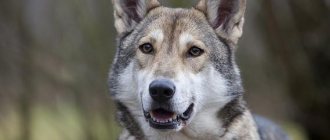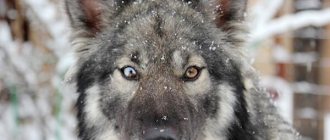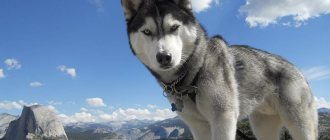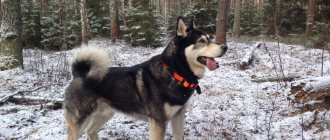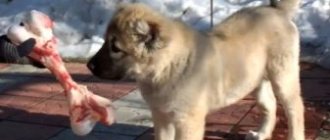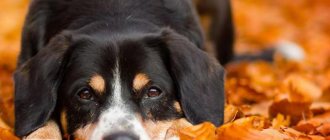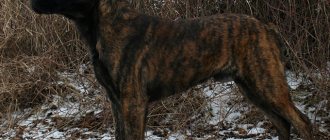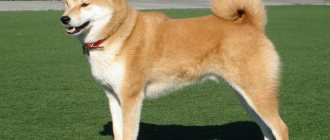This dog appeared in the Netherlands in 1925 after crossing a purebred German Shepherd with a wolf. Lander Sarlos was involved in breeding the breed, and after his death the business was continued by his wife and daughter.
The Saarloos wolfdog mainly lives in its homeland - the Netherlands. It is little known in other countries. Today it is successfully used as a guide for people deprived of vision, for work in extreme search and rescue operations.
Probably, the wide distribution of these animals is hampered by wolf instincts of behavior. This dog lives according to the laws of the pack. Its owner is the leader. What’s surprising is that you don’t need to prove this to the dog in any way. She accepts this situation as a given.
The Saarloos wolf dog, a photo of which we posted in our article, usually keeps its distance from people it doesn’t know and avoids everything that seems suspicious to it.
History of the breed
As already mentioned, L. Sarlos, a citizen of the Netherlands, began breeding this breed. He devoted 39 years of his life to this work. He began conducting his first experiments in 1925, trying to get a shepherd dog that would be endowed with features close to natural ones. He crossed wolves with German shepherds and selected the most desirable colors, in his opinion.
The breeder's task was to obtain the most hardy and strong dogs, without obvious signs of degeneration. In the selection work to develop the breed, Sarlos was helped by his close friend, Dr. A. Hagedorn. The first experiment (1925) did not give the desired result. Wolf's blood was used again only in 1962.
After the death of Lander Sarlos, his wife and daughter continued to improve the breed. A few years later she was officially recognized by the Dutch kennel club. In 1981, the wolfdog was registered with the FCI.
Grooming and hygiene
Russian spaniel: characteristics of the hunting breed
No one cuts the claws of wild animals in nature, combs out their fur, or takes care of the condition of their teeth. The breeder of the Russian Wolfhound Yu. Ivanovich, talking about the goals that she set for herself when breeding a new breed, emphasizes that she strived to ensure that the dogs received from wolves strong teeth, powerful bones, thick hair, and a long life without disease.
Important! Dogs that live permanently in an apartment next to people need to be brushed during shedding, their paws washed after walking along a dirty street, and taken to a veterinarian for age-appropriate vaccinations and parasite removal.
Description of the breed
Many experts consider the main advantage of this dog to be its somewhat rustic, often wild appearance. A luxurious “wolf head” with a slightly elongated muzzle, triangular, high-set ears, slightly slanted, but very attentive amber eyes - you must agree, such a wolf dog can attract attention. This beauty, with muscular and slightly dry limbs, really does look a lot like a wolf - well-developed, well-groomed, ready for long treks, and with great running speed.
The wolf dog moves as easily as its wild ancestor - widely and smoothly. A strong animal easily moves from one running pace to another.
The height at the withers of males reaches 75 cm, females are slightly lower (70 cm). Weight no more than 41 kg.
Coat
The Saarloos wolf dog, a photo of which can be seen in some cynological publications, has an original coat that can change depending on the season.
In winter, the animal develops a thick undercoat. Together with the guard hair, a layer of fur is formed on the dog’s body, and a thick collar is formed on the neck.
In the spring-summer season, the guard hair becomes the main one. In the autumn-winter period, air temperature can affect the presence of undercoat, but it is important that there is always a tendency for its appearance.
Pros and cons of the breed
The main disadvantage of the breed remains its low level of controllability. Breeders and dog handlers have never been able to bring the breed to complete obedience. Taking into account the strength and size of the animal, this factor requires special attention.
The disadvantages of the breed include its natural independence.
The advantages of the breed are obvious:
- devotion, a pronounced tendency to self-sacrifice for the sake of the owner’s life;
- high intelligence and the ability to instantly respond to changes in the situation;
- determination, high physical condition, excellent security and guard skills;
- complete integrity;
- tactful sociability.
Only an experienced dog handler, a clear leader with a strong character, can handle an independent and strong-willed pet.
Character
Saarlos's dog has the temperament of a wolf, tempered by a German shepherd. This is an animal that quickly runs wild, it is unbalanced and prone to wandering. From the wolf she inherited hunting instincts - dexterity when hunting small game. The dog needs space and daily serious physical activity. Thanks to her luxurious “fur coat,” she can live outside at any time of the year.
The wolf dog is an independent creature, but at the same time it is very attached to people. This combination of qualities often makes learning difficult.
Wary behavior towards strangers is not caused by timidity or fear. The wolf dog, photos of which can be seen on the websites of famous kennels, is careful and keeps a distance that allows it to retreat when a threat appears. This is typical wolf behavior. However, she never shows unjustified aggression.
Advantages and disadvantages
The pet is attentive, restrained in showing emotions (especially in front of strangers), treats strangers with caution, without nervousness. In most cases, he behaves calmly, balancedly, and very independently. Loves group games. When hunting, it behaves like a wolf, hiding and waiting for prey . Exercise caution and stay in a safe place.
The breed combines antagonistic qualities: the cunning of a wolf and the courage of a dog; the dog rushes to the defense of its owner without hesitation. Disadvantages of the breed - the presence of such opposite character traits can complicate the puppy's training.
Have you heard of the existence of this young but extremely interesting breed of dog before?
Health
The Sarloswolfhond is unpretentious and independent. From wolves, these dogs have excellent health and powerful immunity. Life expectancy can reach 20 years, on average they live about 15 years. They are resistant to a significant number of diseases. There are no hereditary diseases.
If health problems arise, antibiotics must be used with extreme caution, as they can cause serious complications. Some other medications can also cause unpleasant consequences, so you need to pay special attention to their use.
Saarlos's dogs have difficulty withstanding transport. If they need to be transported over long distances, they are immersed in light anesthesia.
You should not neglect periodically necessary vaccinations, as well as treatments with anthelmintic drugs.
Features of education
Socialization and training of this animal must begin from the moment puppies appear in the house. From an early age, a wolf dog must get used to its surroundings and its new owners. If a puppy is afraid of something, the owner should not show sympathy for him - this will only make the situation worse. It is necessary to remain calm - this will convince the baby of safety and help to gain confidence in his abilities.
If there is not just one Saarlos wolf dog living in a house, but several individuals, then relationships are quickly established between them according to a hierarchy, and they treat each other quite kindly.
Wolf dogs are especially active during the mating season. At this time, there are no barriers for them, therefore, when the owner is not in the house, they must be locked in safe premises.
It must be said that breeding animals of this breed is not an easy task. A female dog usually goes into heat for the first time at the age of two years, then it repeats no more than once a year. Some males show “signs of attention” to certain females, while stubbornly not noticing others.
Saarloos's dog can radically change its behavior in different situations - from complete indifference to unexpected animation.
Breed standard Czechoslovakian Wolfdog
Little top
All members of the family have a strong external resemblance to wolves, but differ from the well-known half-breeds - the wolfdog and the wolfhund. According to the type of constitution, Czechoslovakian wolfdogs are closer to shepherd dogs, therefore they have a less bestial appearance than true hybrid individuals. The minimum allowable height for a male dog is 65 cm; for a female – 60 cm. Sexual dimorphism is also reflected in the weight of animals. If a male Czechoslovakian Wolfdog cannot weigh less than 26 kg, then for “girls” this is more than a decent level, since for them the lower limit of body weight is only 20 kg.
Head
The skull is arched, rounded at the front and sides. With a pronounced occipital protuberance, the frontal sulcus is smoothed and practically invisible. The stop is of medium relief, the narrow muzzle is complemented by a straight bridge of the nose. Cheekbones without a characteristic convexity, but muscular and developed.
Nose
The lobe fits perfectly into the oval shape. The skin color of the nose is uniform black.
Lips, jaws, teeth
The lips, which fit closely to the jaws, do not form hanging “pockets” at the corners, and their edges are painted in a rich black tone. The symmetrically located jaws close in a straight or scissor bite. The teeth are large, with massive developed fangs. The number of teeth approved by the standard is 42.
Eyes
The Czechoslovakian Wolfdog should have slanted and small eyes, with an amber-colored iris. The eyes are covered with thick, dry eyelids.
Predatory look
Ears
Short, classic triangular shape. The thin ear flap is always kept in a standing position. An important breed feature: an imaginary straight line can be drawn between the outer corners of the eyes and the outer corners of the ears.
Neck
The neck of the Czechoslovakian Wolfdog is elongated, dry, with dense, easily palpable muscles. The normal tilt of the neck to the horizon is up to 40°.
Frame
Where is your barrel?
The Czechoslovakian Wolfdog is distinguished by its strong build and rather tall stature. The dog's back is flat, with a slight slope. With pronounced withers, the top line is as smooth as possible. A short loin that does not expand in width is connected to an almost horizontal, well-developed and equally short croup. The pear-shaped chest is not lower than the level of the elbow joints, the front of the chest never protrudes beyond the line of the shoulders. The belly, which is sunken from the sides, is strongly tucked, which gives the animal’s silhouette a pleasant gracefulness.
Limbs
The dog's front legs are located close to each other, with the paws slightly turned outward. The shoulder blades form an angle of about 65°. The shoulders are developed, the elbows are mobile, strong, and stay close to the body. The forearms and metacarpus are elongated.
The hind limbs of the Czechoslovakian Wolfdog are quite powerful, parallel to each other. Massive long thighs form an angle of 80° with the pelvic bones. Flexible knee joints extend into muscular long shins. The joints are strong, with angles of 130°. The hocks are almost vertical.
The dog's paws are elongated, with arched toes ending in strong black claws. The animal moves at an amble (in a calm state) or at a trot (in an excited state), stretching its neck and head forward.
Tail
High rise, hanging down. An excited dog's tail takes the shape of a sickle and rises.
Wool
Czechoslovakian Wolfdogs have a pronounced seasonality of cover. In winter, the coat is thick with a plump layer of undercoat, which is noticeably larger than the guard hair. By summer, the volume of the undercoat decreases, but the outer coat remains quite thick and dense.
Color
Any color is possible in the range from silver-gray to yellowish-gray. There is a light mask on the wolfdog's face. Other areas with lightened coat: chest, inner neck. Not always, but a dark gray color with a lightened mask is allowed.
Disqualifying faults
Me and my crazy friend
- Cowardice or emphasized aggressive behavior.
- Loss of teeth (the absence of two PM1 and one M3 is not counted).
- Weak ligaments.
- Any color other than those specified in the standard.
- Irregular shape of the skull.
- Croup with a sharp slope.
- Availability of suspension.
- The coat does not adhere to the skin and has a soft or wavy texture.
- Incorrectly set tail.
- Ears of an atypical shape, set too high or low.
- The eyes are not slanted, but rounded.
- Incorrect leg position or chest shape.
Exterior defects for which the Czechoslovakian Wolfdog receives a low score at the exhibition: flat forehead, undefined mask, short wavy movements, weak muscles. The iris is also fined if it is dark brown in color, if the eyes are different, or if the head is too heavy or light.
Price of Russian Wolfhund
The breeder of the breed in her messages asks to discuss the prices of the dogs personally with her. To do this, she indicates the necessary contacts in her blog. She sells not only breeding dogs, but also neutered ones.
Russian Wolfhunds, Yulans, and Arctic dogs are modern animal species with enormous capabilities and unique characteristics. Not everyone can be the owner of such a dog. The potential owner must be aware of whether he can cope with raising a pet and whether he has the opportunity to maintain it.
Possible diseases and methods of treating them
Unfortunately, active and energetic large dogs often face the problem of damaged legs. While running, they may fall, dislocating or breaking a leg. If you see your pet fall unsuccessfully, we advise you to leave him in a lying position and call a veterinarian at home.
Well, if this is not possible, you will have to put a splint on the dog and transport it to the clinic yourself. If your Great Dane constantly whines and doesn't move much, he may have joint dysplasia. In this case, he will need professional help.
As additional care for your dog, give it anti-parasite medication every summer, and feed it with fresh fruits and vegetables in winter. You can also pamper your four-legged pet with non-acidic berries, such as watermelon (in season, of course).
The Great Dane is a wonderful dog. He is kind, loyal and playful. It is pleasant to interact with him, both for children and adults. Remember to systematically care for your animal to ensure its lifespan is as long as possible.
Purpose
The Saarloos wolf dog can become a reliable friend to all family members. However, it should be noted that this is more difficult to achieve than with other dog breeds. Their upbringing may take much longer than the owner expects.
Don't forget how capricious Saarlos's wolf dog is. During training, puppies can, at the owner’s command, bring the required item twice, and the third time they can simply refuse to obey the command.
Despite the fact that good contact is usually established between this dog and a person, it seems that he never forgets his nature. Therefore, those who want to get a wolf dog need to be patient.
Performance evaluation and information
We will evaluate learning ability, intelligence, security and watchdog abilities, friendliness, as well as difficulties in caring for the dog.
Learning ability. In terms of training, the wolfdog is a middle option. The blood of a German Shepherd flows in her veins, and they are famous for their good trainability. However, as we know, it is impossible to train a wolf, so although a wolf dog can be trained, it will not be possible to turn it into an agility winner.
Smartness. Here we are looking at mental qualities. The breed is distinguished by high intelligence, which is why it surpasses German shepherds in the speed of searching for prey or any materials.
Security and guard abilities. The breed was originally bred for these purposes, and is also classified in the appropriate group, therefore receiving the maximum score.
Friendliness. By this word we mean the attitude towards the owner and his family. It is no secret that wolves are not known for their friendliness and are ready to attack any uninvited guest. The German Shepherd is not overly aggressive, but the wolf mixture “kills” its friendliness. As a result, the friendliness of the wolfdog is rated 6 points out of 10. This rating indicates that the Sarloos dog is not suitable for the role of a nanny for your child.
Difficult to care for. The breed is extremely difficult to care for, which is primarily due to the character of the dog.
How to care for it?
Start carrying out all manipulations early and slowly. Don't force it. Let me smell the treatment supplies. Touch them to your body as if you are flirting. This unobtrusive action will drive away fear. Then your ward will allow you to clean his mouth and so on.
To maintain your grooming, you need to do the following:
- When shedding occurs, brush with a special brush.
- Swim only in the summer or spring months. Use half as much shampoo as you need for washing so as not to dry out your skin. In the winter cold, you risk washing off the protective layer , which protects against freezing.
- Brush your teeth twice a week. For this, there is an edible paste with a taste of fish or meat. It neutralizes unpleasant odors and removes accumulated plaque. On other days, use vein bones or dried lungs. You can chew them every day.
- Inspect the ears and remove wax as needed.
- Wipe the eyes with tea leaves if you find dirt or mucus clots in the corners. If it is brown or transparent, this is normal.
- Trim the nails if they do not grind down on their own. If this thing is neglected, the gait becomes deformed.
Don't forget about sports. Staying outside should include increased load - running, jumping, carrying a load - for example, a sled or a car camera. This helps maintain normal physical shape and strengthens the immune system. If your pupil is in an enclosure, there is no need to insulate him. It is wonderfully adapted to survive any bad weather.
The only thing that is better to take care of is a reliable and high fence. These are fans of digging ditches and holes, so it is recommended to concrete the space along the fence. They are also not averse to jumping over obstacles, so a low fence is not an option for you.
If treated with dignity, your wolf cub will become a devoted companion in all daily activities and will be a wonderful protector for your family.
Caring for the Karelian Bear Dog
Caring for the Karelian Laika requires the owner to follow standard procedures, but training must be especially thoughtful.
Feeding
Karelian huskies are active and energetic; accordingly, their diet should be well-balanced and high-calorie. Industrial diets that fall into the holistic and super-premium categories and are designed for highly active pets (for example, Acana Sport & Agility, Eukanuba Jogging & Agility, etc.) cope well with this task.
When feeding a hunting dog, it is important to use high-quality food for active breeds
Feeding natural food should be based on the general rules for feeding medium-sized animals:
- more than 50% of the diet is meat (rabbit, chicken, turkey, beef), valuable offal (liver, heart);
- inclusion of vegetables and unsweetened fruits;
- Be sure to add low-fat fermented milk products;
- adding healthy cereals (buckwheat, rice, bran);
- exclusion from the diet of fatty meat (pork, lamb), tubular and fish bones, potatoes, sweets, baked goods, spices, etc.
General care
The densely packed coat of representatives of the breed outside of shedding requires standard care:
- combing with a brush or metal comb 2-3 times a week;
- bathing as necessary, 3-4 times a year (if the dog gets dirty, just wipe it with a damp cloth);
- haircut is not provided.
During shedding, combing should become daily, and you can additionally use a furminator - a special comb with blades that more effectively removes falling hairs.
After a hunt, it is important to inspect your pet’s ears, nose and eyes for injuries, thorns, twigs, and ticks. Provided you get enough walks, there is no need to trim your nails specifically.
Training
During the formation of the breed, preference was given to its working hunting qualities, therefore a strong dog requires professional training
It is important to exclude activities used for guard and protective service - this will provoke unnecessary cruelty for the representative. During training, the owner must show rigidity and rigor.
Socialization is extremely important for Karelian bear dogs to develop tolerance towards other animals.
Walking and conditions of detention
The energy of Karelian bear dogs, and especially their loud barking, usually interferes with their comfortable existence with people in apartments. It is recommended to keep such pets in closed enclosures or private homes, but with mandatory daily walking and running, jumping and other physical activities. Walks should be long, at least 2–3 hours a day.
Maintenance and care
Keeping such a dog is not difficult. It usually doesn’t require any complicated care for its coat. The animals feel quite comfortable in the spacious enclosure. Group housing is preferable. Do not forget that the Saarloos wolf dog (reviews from the owners confirm this) quickly runs wild and has a tendency to wander. Without receiving proper education and attention from humans, they turn into an ordinary wolf pack. And this, as you understand, can lead to many troubles.
Czechoslovakian Wolfdog price
The cost of a Czechoslovakian Wolfdog puppy from renowned producers is from 60,000 rubles. It is better to look for purebred representatives in official nurseries like “Romtat”, “Malakhovsky Wolfhound” and others. The cheapest, and sometimes even free, option is adult specimens, which are often sold through virtual bulletin boards. Typical reasons that encourage owners to get rid of their dogs are animal aggression, moving to a new place of residence, a busy work schedule that does not allow them to control the dog’s behavior.
Predisposition to pathologies
A kind of incest served as a strong foundation for excellent health. This combination of genetic code made their immunity stable, which is what the discoverer of this species was striving for. These are born long-livers. Their life expectancy is 15-20 years , but even in old age they feel great.
They do not have diseases caused by genes. If there are some flaws, then they are acquired; heredity has nothing to do with it. The resulting ailments are a consequence of improper cultivation. When the body is weakened, resistance to viruses decreases and the risk of injury increases.
For harmonious development and growth, provide balanced feeding. Additionally, give vitamins and mineral complexes. Strengthen ligaments, bones and tendons by taking special medications. The load is only in accordance with age. You can’t keep a baby or an adult locked up, but you shouldn’t drive them to a half-dead state either. Do not forget also about prevention against worms, ticks and fleas.
Choosing a puppy
As already mentioned, this is not a very common breed in Russia - the Saarloos wolf dog. Not every city has a nursery that breeds this breed. However, if you are determined to get such a dog, we strongly recommend purchasing it only from a kennel (St. Petersburg, Voronezh, Petrozavodsk, Rostov-on-Don, Moscow). This is a dog (Sarloos wolfdog), whose puppies (especially at an early age) should under no circumstances be bought at the market. You can buy an unhealthy animal and, moreover, one that has nothing to do with this breed.
Puppies certainly need early socialization and training, but it is equally important to teach them how to behave properly when alone. Otherwise, in the absence of the owner, they will be very sad and rush to him, destroying everything in their path.
Description and characteristics of other types of Wolfhounds
Hybrid animals, obtained spontaneously by mixing the blood of feral dogs and wolves, have existed in nature as long as dogs have existed. Following nature, people began to mix blood in pursuit of their mercantile or noble goals.
Black Russian Terrier: description of the dog breed
Today in the world there are several more or less stable hybrid breeds, including:
- American Tundra Shepherd;
- Saarloos Wolfhound;
- Sulimov's dog.
Important! Wolf-dog hybrids should not be kept in families that do not have the skills to handle large-breed dogs. They require discipline, early socialization and constant training.
Wild hybrid individuals are strong like wolves and are not afraid of humans like dogs. Wolfops, created by humans, have their own characteristics.
Some breed groups did not develop and ceased to exist, many hybrids are in the breeding stage.
Hybrids of the 1st generation: wolf-dogs from the Russian nursery Wolfriend - “Wolf-Friend”
American Tundra Shepherd
They began to breed it to meet the needs of the army. The work was carried out on behalf of the US government. They mixed the blood of shepherd dogs with tundra wolves. The first results were unsatisfactory. Instead of smart, obedient, hardy dogs, they got aggressive, difficult-to-train puppies. The program was closed.
But the breeders decided to continue their work. New hybrid dogs have become amenable to education and training. But their character as harsh tundra animals must be overcome from an early age. Dogs can be family companions, guards, guides, and rescuers. They have an excellent sense of smell and memory.
For your information! Now American Tundra Shepherds have gained great popularity in their country, but the breed has not been recognized by cynological organizations.
American Tundra Shepherd
Wolfdog of Saarloos
The breeding of Saarloos Wolfhund dogs began in Holland. Breeder L. Sarlos crossed a German shepherd with a she-wolf from the zoo. His first attempts did not bring the desired result, which is probably why he did not leave accurate data on all his selection operations.
After the death of the breeder, his business was continued by close relatives. In 1975, they managed to breed dogs whose qualities were recorded by the international FCI standard. Dogs of the breed have a wolf-like appearance, body structure, eye color, coat color, and life expectancy. They don't bark, they can howl at the moon. They are used as service dogs, they are able to find people buried in avalanches, and can work as guide dogs for the visually impaired.
Dogs of the Saarloss Wolfhound breed
Sulimov's dog
When breeding the breed, the needs of the security forces of the USSR Ministry of Internal Affairs were taken into account, which needed service dogs with an impeccable sense of smell to search for herbal drugs. For breeding work, dog handlers chose Central Asian jackals, whose diet half consists of berries and other plants.
For your information! The blood of cold-resistant reindeer herding Nenets Laikas was added to the blood of heat-loving jackals.
After seven years of work, dogs were obtained with strong bones, muscles, unusual agility and excellent search abilities. Puppies begin to be trained at 2 months of age. They are able to find explosives, drugs and substances with a subtle odor. They are actively used to inspect Sheremetyevo Airport and the vehicles located there.
Sulimov's dogs at work at the airport
Purpose
The Sarlos dog is used as a service dog, in rescue operations, in police service, to search for people under rubble, avalanches, and in other extreme natural situations. Sometimes used as a guide. The breed is distinguished by loyalty, well-developed hunting instincts, is sociable and slightly aggressive.
Use of wolfdog
According to the international classification, the Saarloos dog belongs to the shepherd dogs. But few people use this breed for herding livestock. Even the author of the breed himself said that there was no goal in breeding a new shepherd breed.
Now this is a very rare breed. Perhaps this is one of the reasons why wolfdogs are not used for herding. But, it seems to us, the main factor is the innate hunting instinct. It is expressed much more strongly in Saarlos's dog than in other shepherd dogs.
In addition, herding is made difficult by the dog’s poor receptivity to training. You should not expect wonderful play with sheep from this breed, as collies, Aussies, and kelpies do. Also, the wolf dog does not exhibit pronounced guarding qualities, as is the case with large shepherd dogs - South Russian, Commander, Bobtail.
But the wolf dog has completely different qualities. This is a very cautious and reserved animal. This allowed her to be used as a guide dog. The wolf dog does an excellent job with this job.
Saarloos wolf dog: reviews from owners
Today in our country there are still not too many owners of these animals. However, reviews about this breed are already appearing on the websites of nurseries and clubs.
According to the majority of owners of these dogs, this breed is not suitable for every person. It should not be owned by beginners in dog breeding or people with too soft a character. But with proper upbringing, you can grow a cute “wolf cub” into a wonderful and loyal friend.
Interesting Facts
- In 2010, 300 thousand wolf-dogs were registered in the world;
- The more dog blood, the more aggressive the wolfdog;
- These animals can easily live in an apartment, but feel best in a private home;
- A cross between a shepherd and a wolf is better trained by women than by men. There are no explanations for this feature yet;
- Their favorite delicacy is not meat, but... sweets. They go crazy over sweets, marmalade, marshmallows, chocolate;
- *The highest quality hybrids are obtained if the father has a balanced character and is loyal to people;
- They love to lick their owner's teeth...
- There is no rabies vaccine for wolfdogs;
- They howl more often than bark.
